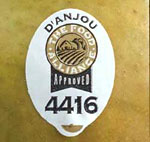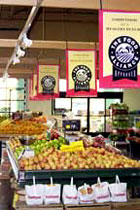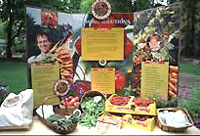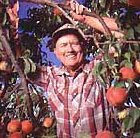Deborah Kane, Jonathan Moscatello, Scott Exo, and Cindy Hayford all for The Food Alliance, a nonprofit organization dedicated to promoting environmentally and socially responsible agriculture.
Tuesday, 29 May 2001
PORTLAND, Ore.

Deborah Kane, Food Alliance executive director.
First, let me introduce myself. I’m Deborah Kane, and I play the role of executive director here at The Food Alliance. Other players include my six colleagues here in Portland, the 60 Food Alliance-approved farmers and ranchers in the Northwest, our wholesale and retail partners, our colleagues at The Midwest Food Alliance in Minnesota, our board of directors and stewardship council, and, last but certainly not least, the consumer members and shoppers who buy Food Alliance-approved products at their local grocery stores, farm stands, and farmer’s markets. Each member of our team plays an integral role in pursuing our vision of marketplace rewards for farmers and ranchers practicing sustainable agriculture.

Here’s how our program works: Farmers and ranchers who meet our strict eligibility criteria label their products with The Food Alliance seal of approval. Consumers look for the seal when they shop and buy with the knowledge that they are supporting farmers who are caring for the environment and providing safe and fair working conditions for farm workers. (Tomorrow, learn more about the approval process and join us for a visit to a Food Alliance-approved farm.)
Credibility with consumers is at the core of our program’s success. (Later this week, you’ll have the opportunity to see how we are doing this in both farmer’s markets and supermarkets across the Northwest.) While we aspire to create marketplace rewards for responsible producers, we make it pretty tough for them to earn our seal of approval. Food Alliance-approved farmers represent the cream of the crop, practicing environmental stewardship and social responsibility.

Our banners in a Thriftway grocery store.
In fact, ensuring credibility is so important to us, we created a Stewardship Council to bring together a diverse group of agricultural experts and stakeholders to regularly review our evaluation criteria. The council consists of representatives from Environmental Defense, Oregon Environmental Council, Defenders of Wildlife, the Office of Rural and Farmworker Housing, the state university system, and the state government.
We are further adding strength to The Food Alliance name by forming partnerships across the country. This year we forged a partnership with The Midwest Food Alliance in St. Paul, Minn., and we are currently exploring a number of opportunities for expansion to other regions as well.
Over the next few days, I hope you’ll join my colleagues and me as we reveal how each of our programs is doing its part to encourage sustainable agriculture practices and to provide you with good food for a healthy future!
Wednesday, 30 May 2001
PORTLAND, Ore.
Hi, I’m Jonathan Moscatello, the agriculture program manager here at The Food Alliance. My day is typically filled with recruiting producers for the program and meeting the needs of the producers who are currently Food Alliance-approved. It’s pretty rewarding work to be creating incentives for innovative farmers and ranchers who are protecting the environment and considering the welfare of their workers. I’m meeting this morning with Oregon Country Beef ranchers, and this afternoon, I’ll be heading south to visit Stahlbush Island Farms in Salem, Ore.

Me (on the left), with two generations of Food Alliance-approved farmers.
Right now, The Food Alliance is conducting evaluations of all the OCB ranches with our seal of approval. We’re pretty excited to be working with OCB, a cooperative of small, family-owned ranches throughout Oregon. OCB ranchers are working hard to hold on to a rich heritage of ranching, while treating the land with respect. A few of OCB’s stewardship practices include controlling overgrazing, conserving water, encouraging a diversity of vegetation, and protecting wildlife habitat. OCB also does not use growth hormones or feed-additive antibiotics. In a nutshell, OCB does its best to ensure “long-term health and productivity of the land rather than short-term gain.” When a cooperative of family ranchers makes a promise like that, it is important to me that The Food Alliance finds a way to communicate this to consumers through our seal of approval. OCB’s product, known as “Country Natural Beef,” is currently marketed through Whole Foods and Wild Oats/Nature’s Northwest stores in California and Northwest markets.

Bill and Karla Chambers at Stahlbush Island Farms.
I am equally thrilled to be working with Stahlbush Island Farms, a relatively large fruit and vegetable operation located in the heart of the Willamette Valley near Corvallis, Ore. Since Bill and Karla Chambers acquired Stahlbush Island Farms, Inc. in 1985, the farm has become known as a leader in sustainable agriculture. A few of the practices that are conscientiously observed on the farm include rotating crops over a seven-year period, planting cover crops, protecting groundwater, recycling, and composting. Because Stahlbush Island Farms is committed to being a steward of the earth, The Food Alliance is committed to its success. Stahlbush Island Farms products can be found in Fred Meyer stores across the Northwest as well as in Wild Oats/Nature’s Northwest markets.
You may be wondering how The Food Alliance can be so sure that the farms we endorse, such as Stahlbush Island Farms and Oregon Country Beef, are living up to our standards of environmental and social responsibility. This is a two-step process. First, the producers that wish to become Food Alliance-approved send in a detailed application that explicitly outlines their practices. Then a third-party inspector visits the farm or ranch for an on-site evaluation using commodity-specific evaluation criteria (we have specific guidelines for over 200 commodities). The inspector then submits the evaluation to me, and if the operation has achieved a 70 percent score or better in all categories, it becomes eligible to market its product using our Food Alliance-approved label.
Thursday, 31 May 2001
PORTLAND, Ore.

Scott Exo, Food Alliance program director.
Good morning! I’m Scott Exo, program director at The Food Alliance. My goal today is to find two Food Alliance-approved farmers to commit to doing a demo of their products in a participating grocery store.
While it takes some logistical work to get a farmer into a grocery store, especially during harvest season, we make it a priority for two reasons. First, demos increase product sales almost without fail. Second, connecting the consumer face-to-face with local farmers is a pretty unique experience, and reminds people that food doesn’t just come from grocery store shelves. These good old-fashioned interactions create a bond between consumers and farmers, and give farmers the opportunity to tell customers what is special about their farm.
Successful demos send a real vibe throughout the store. The combination of the aroma, the conversation, the delicious product, and the philosophy behind our name results in a meaningful experience for the shoppers and the farmer.

Apple and pear grower Gary Wells.
My first call will be to John Wells of Wells and Sons Orchards in Hood River, Ore. Operations at Wells and Sons Orchards are divided among the family members: Gary, Maureen, John, Carolyn, Jim, Jean, and Scott Wells. The Wells grow apples and pears, and I’m particularly eager to have John demo their fruit in a supermarket, as they utilize really innovative pest and disease management practices.
In 1996, John tested pheromone-mating disruption, a new technique to control codling moths. Codling moths lay eggs in fruit and the larvae eat the young pears. Codling moths don’t see very well and only fly at night. The female moths rarely fly at all. They sit on branches and release pheromones so that the male moths know where to find them. At bloom time, John places dispensers in his orchard that release clouds of pheromones. Males fly around looking for females to mate with, but the scent of pheromones is so overpowering, they never can find the females. The males die frustrated, and the females never have a chance to mate and create new codling moths. When successful, this method obviates the need for pesticides. After early experimentation with the technique, John found pheromone-mating disruption to be so successful, he placed dispensers on 115 acres. This is the type of agricultural innovation we want consumers to hear about, so I’m eager to provide an opportunity for John to tell his story.
My second phone call of the day is to Lon Inaba of Inaba Produce Farms, Inc. in Wapato, Wash. Lon and his family grow asparagus, peppers, cabbage, cucumbers, beans, onions, peas, corn, zucchini, tomatoes, and watermelon on 1,200 acres.

Lon Inaba checks his crops.
Lon has two Department of Health-licensed housing structures for his farmworkers. He took out a low-interest Farmers Home Administration loan for the materials, and with the aid of his workers, built housing that has earned praise from the Washington Governor, the EPA, and the Washington State Department of Community Development. Because of the steps Lon has taken to ensure a healthy work environment, many of his employees return each year, providing him with a knowledgeable and well-trained staff.
The Food Alliance is proud to provide our seal of approval to farmers like Gary and Lon. We’re working hard to connect consumers to the men and women who put food on their tables. So don’t be surprised to see a Northwest farmer serving up asparagus in your neighborhood market sometime soon. And if you do, stop by and give Food Alliance-approved a try. You won’t be disappointed!
Friday, 1 Jun 2001
PORTLAND, Ore.

Cindy Hayford, Food Alliance direct market coordinator.
Hi, I’m Cindy Hayford, the direct market coordinator for The Food Alliance. This morning, I’m preparing point-of-sale materials for a booth I’ll be setting up this Saturday at the Beaverton Farmer’s Market in Beaverton, Ore. Over the course of the summer, I’ll be attending five different farmer’s markets throughout Oregon. I’m particularly excited about the Beaverton Market, as it’s recognized as one of the best markets in the West and always has a huge turnout.

A Food Alliance booth at a Northwest farmer’s market.
My main objective this weekend is to educate shoppers about what The Food Alliance seal of approval represents. Armed with fact sheets, recipe cards, brochures, and display boards, I aim to explain to shoppers that Food Alliance-approved products are grown by farmers and ranchers who are reducing or eliminating their use of pesticides, conserving soil and water, and providing safe and fair working conditions for farm workers.
Generally speaking, farmer’s markets attract a crowd of consumers that are looking for locally and responsibly grown fresh produce, and are really interested in what we’re doing. I also know nothing engages people more easily than delicious food, so I’ll be offering free samples of strawberries from Food Alliance-approved Unger Farms, who regularly sell at the Beaverton Farmer’s Market.
This ties in with my second objective for tomorrow, which is to direct people to the Food Alliance-approved farmers at the market. Unger Farms and Enchanted Hill Farm, both located in Cornelius, Ore., will be displaying Food Alliance banners and stickers at their booths. My experience has been that once people know which farmers are Food Alliance-approved, they’ll head straight to those booths.
Unger Farms, Inc., owned by Matt and Kathy Unger, produces strawberries, blueberries, and grapes on its 80 acres. Perhaps the farm’s success can be credited to the energy with which the Ungers tackle farming. This is evident in their involvement in seven farmer’s markets in the Portland area and the amount of time they spend continuing their education in agricultural issues. Matt and Kathy use light tillage methods and plant hardy grasses to strengthen the soil, prevent erosion, and control weeds.

Don Anderson in one of his peach trees.
Our other farmer in the market this weekend, Don Anderson of Enchanted Hill Farms, grows 13 delicious varieties of peaches, continuing the tradition his parents started in 1932 when they bought farmland near Cornelius. He also has earned an agriculture degree from Oregon State University. Recently retired from the U.S. Geological Survey, today he pursues his long-standing dream of restoring “the Oregon I knew as a child.”
With impressive views and desirably clean well water, Don’s property could easily be sold to build an elite subdivision. However, in Don’s words, “conserving and restoring land and delaying commercial development are lifelong passions of mine.” In time, Don’s daughter, Charlene, and her husband hope to run the farm, expanding production and building a nursery business.
I am inspired by the philosophical beliefs of both the Ungers and Don Anderson, and by the practical way in which they apply these beliefs to their farming operations. As I prepare for the market tomorrow, I’m delighted to have the opportunity to acknowledge the accomplishments of Food Alliance-approved farmers and to spread the news of how consumers can support these socially and environmentally responsible farmers with their shopping dollars.

